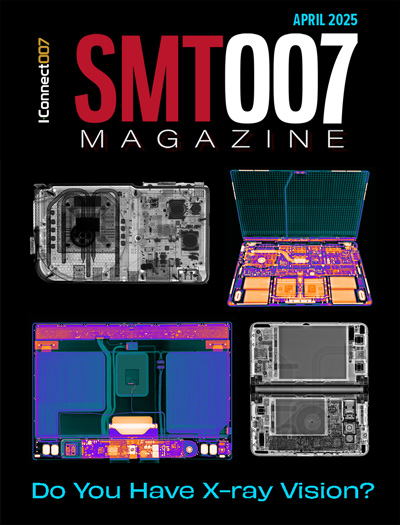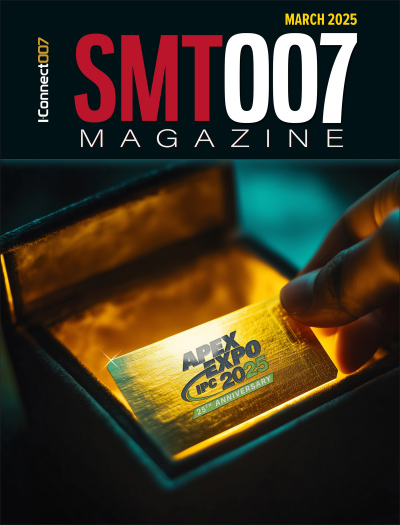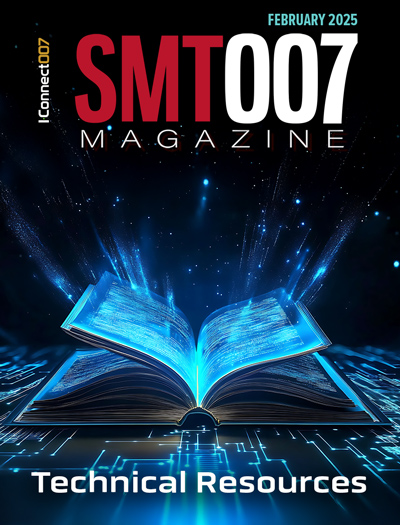-

- News
- Books
Featured Books
- smt007 Magazine
Latest Issues
Current Issue
Do You Have X-ray Vision?
Has X-ray’s time finally come in electronics manufacturing? Join us in this issue of SMT007 Magazine, where we answer this question and others to bring more efficiency to your bottom line.

IPC APEX EXPO 2025: A Preview
It’s that time again. If you’re going to Anaheim for IPC APEX EXPO 2025, we’ll see you there. In the meantime, consider this issue of SMT007 Magazine to be your golden ticket to planning the show.

Technical Resources
Key industry organizations–all with knowledge sharing as a part of their mission–share their technical repositories in this issue of SMT007 Magazine. Where can you find information critical to your work? Odds are, right here.
- Articles
- Columns
Search Console
- Links
- Media kit
||| MENU - smt007 Magazine
Advances in Automated Selective Conformal Coating
December 31, 1969 |Estimated reading time: 7 minutes
Tri-mode applicator technology offers manufacturers both flexibility and dependability.
By David M. Selestak, Christopher E. Havlik and Debra Fazekas
Since its inception nearly 10 years ago, automated selective conformal coating has proven superior to traditional coating methods for reducing material usage, labor costs and minimizing environmentally hazardous solvent emissions. In addition, the coating process is programmable, offering uniform coverage and repeatability. Because material is being dispensed selectively,
 Figure 1. The bead mode applies a stream of material to the substrate.
Figure 1. The bead mode applies a stream of material to the substrate.
up to 100 percent transfer efficiency can be achieved, dramatically reducing material waste. Recent developments in dispensing technology have further enhanced the automated conformal coating process, providing greater flexibility, better control of film thickness and easier programming. Using tri-mode applicator technology, manufacturers can apply thinner film builds of conformal coating over a wider area at high line speeds. To date, the tri-mode applicator has demonstrated outstanding flexibility, handling materials with viscosity ranges from 30 to 3,500 centipoise. As a result, desired film thicknesses are not only achievable, but may be varied; selectivity is maintained regardless of the material being dispensed.Theory of OperationA tri-mode system is equipped with dual fluid and air-assist pressure capabilities that are software configurable and controlled. Varying the fluid volume and the corresponding velocity of the shaping air applied to the fluid stream maximizes flexibility. As a result, three distinct modes of operation are achievable from a single dispense head. These modes create three unique dispense patterns: bead, monofilament and swirl.
Dispensing software and hardware work together to provide instantaneous, on-the-fly mode switching capabilities. In addition to the three spray patterns, using the low- or high-shaping air only as an air knife allows coating under components. A dispensed bead of material is followed with an air knife to create a wave effect, moving the material toward the desired area.
The spray patterns and volume of material being dispensed are influenced by several factors:
1. Material rheology (properties including viscosity, surface tension and elasticity).
2. Velocity of material as dispensed from the nozzle (fluid pressure and nozzle orifice size).
3. Volume and velocity of shaping air or air assist.
4. Speed or velocity of robot travel.
5. Dispense height (distance from nozzle to the substrate).
The applicator features a streamlined, slim design that simplifies programming, especially on printed circuit boards (PCB) with taller profile components. In addition, coating quality is maximized with uniform, consistent and repeatable film thicknesses. Multiple film thicknesses and pattern widths are achieved by manipulating the system software.
Process Descriptions by ModeBead. The bead mode applies a singular stream of material to the substrate (Figure 1). It is typically dispensed in areas where components are very close to keep out areas. In addition, it also may be used where extra material is required for protecting high-impedance areas or components requiring structural support.
The volume of material and width of the bead can be varied by adjusting the robot travel velocity. Using the bead mode provides excellent edge definition, making it useful for outlining or framing areas previously coated using the swirl mode to improve the cosmetic appearance of the board.
The bead may be used in a spot command at a stationary location for coating a single test point or component. By increasing or decreasing how long the valve is open, the amount of material being dispensed in a spot command may be varied. In areas where material is required under components (such as a transformer), a bead can be dispensed along the component's edge, followed by a high- or low-air assist to move the material under the component to the leads.
 Figure 2. The monofilament mode spins a stream of material into a conical-shaped pattern.
Figure 2. The monofilament mode spins a stream of material into a conical-shaped pattern.
Monofilament. The monofilament mode is a single continuous strand of material that is spun gently on its axis by the shaping air as it exits the nozzle (Figure 2). It uses an extremely low volume of air pressure to shape the fluid stream. As the material stream spins on its axis away from the nozzle, it stretches and forms into a conical-shaped looping pattern. The looping pattern overlaps onto itself and flows together as the robot travels, providing complete and excellent coverage of horizontal and vertical surfaces.The width of the pattern is determined by dispense height or the distance of the nozzle from the substrate: the higher the dispense height, the wider the pattern up to 1". The volume of material is detemined by robot travel velocity: the slower the velocity, the more concentrated the material, resulting in thicker film builds.
Monofilament mode provides film builds from 0.004 to 0.012" with solventless materials, and 0.00075 to 0.002" with solvent-based materials (primarily solvent-based silicones). In addition, this mode offers excellent film build uniformity and edge definition. The success of the monofilament mode is heavily influenced by the elastic properties of a material. The material must be elastic enough to be stretched into one long continuous strand without breakage. This mode is often recommended when applying 100 percent solids materials.
 Figure 3. Swirl mode uses air pressure to form the material into an atomized spray.
Figure 3. Swirl mode uses air pressure to form the material into an atomized spray.
Swirl. The swirl mode models the monofilament mode, but uses higher air shaping pressures (Figure 3). This higher air pressure breaks up the material into tiny droplets that are held together by centrifugal forces. The result is a lightly atomized, concentrated spray pattern that maintains control and provides excellent coverage of horizontal and vertical surfaces. This mode is often recommended in mil-Spec applications. As with any atomized spray process, the closer the nozzle is dispensing to the substrate, the cleaner the edge definition.The swirl mode provides uniform film builds, achieving builds of 0.001 to 0.004" with solventless materials, and 0.0005 to 0.003" with solvent-based materials, depending on the chemical composition of the material. The success of the swirl mode is influenced by the ease of the ability to atomize the material. Materials with low elasticity work best, producing the best edge definition and uniformity. Film builds and pattern widths can be varied by increasing or decreasing robot travel velocity and dispense height.
Software-programmable Pattern ChangesMany times, a single board requires more than one dispense mode for proper coating. For these cases, the applicator can be configured to dispense in tri-mode, providing on-the-fly pattern changes as the board is coated.
Programming the tri-mode applicator is simple when using Windows NT-based software. This intuitive interface allows the operator to create mask regions and configure multiple tools or patterns in minutes. Defining a mask region automatically turns off the applicator over the specified areas. This makes the use of area coats where two points define an area to coat readily available.
The software incorporates integrated cut, copy, paste and delete functions common in Windows applications. Multiple coating commands can be edited at once, minimizing the time required to program pattern changes.
Because material viscosity may vary from batch to batch, the required offset times will also be affected. A characterization program is used to calculate the applicator's required on and off response times. Material characterization eliminates the need to edit programs because of slight changes in viscosity and is stored with the machine parameters. As a result, commands only have to be executed once for each tool, regardless of how many different board types are being coated. The ability to configure almost an unlimited amount of programming tools allows the operator to characterize at different dispense heights.
ConclusionThe advantages to selecting the tri-mode approach to conformal coating applications are underscored when the technical abilities are translated into bottomline values.
The system supports material cost savings through its unique ability to apply uniform thinner film builds while performing at high line speeds. This can provide a substantial cost reduction over a production run.
Windows-based software is intuitive, easy to learn and permits on-the-fly dispense pattern changes for maximum process control and excellent through-put results.
The selection of which fluids will be dispensed, while initially driven by the application, is also influenced by other factors that can result in the need to manage fluid changes. These factors include environmental issues, customer mandates or cost management issues. The ability to dispense fluids of wide-ranging viscosities without a change in hardware is a significant factor in achieving time and cost savings. There is no need to purchase additional tools, train on more than one tool or fine-tune for desired performance each time a tool is changed. Consistency in the application process and procedures results in better quality management. Instead of ramping up to quality with each tool change, users can rely on one tool that is already able to do three different patterns with many fluids.
The ability to dispense different patterns from one head is a significant factor when selecting a system. Simply put, there is more performance bang for the buck when one tool can do the job of three. There are other individual ways to apply a bead or swirl-like pattern, but tri-mode dispensing represents the only way to accomplish the monofilament pattern. The system not only applies all three patterns, it does so with nothing more than a software command. Every other system requires either multiple tools or a tooling change.
Another important point is that two tri-mode heads can be mounted on the same system to double the performance. This enables dispensing of two different fluids in three different patterns for each head, giving six options at any given time and resulting in faster cycle times. This ability to process more units per hour means tri-mode conformal coating can significantly improve the manufacturing process bottom line.
DAVID M. SELESTAK, CHRISTOPHER E. HAVLIK and DEBRA FAZEKAS may be contacted at Nordson Corp., 555 Jackson St., Amherst, OH 44001-2496; (440) 985-4098; Fax: (440) 985-1122; E-mail: electronics@nordson.com.


